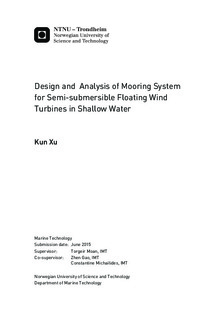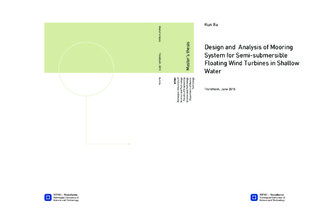| dc.description.abstract | There has been a remarkable development in offshore wind energy. From the view of cost efficiency, floating wind turbine becomes more competitive than bottom fixed wind turbine when the water depth comes above 50 m. Semi-submersible floater concepts have been proposed to be deployed in shallow waters (50 m - 100 m) because of its smaller draft compared to other floater types.
However, mooring system design is extremely challenging for floating structures in shallow water. There is a transition from linearity to nonlinearity in the relationship between mooring line tension and offset at the fairlead, which indicates a potential for extremely large mooring line tension during harsh environment when the floater motions have large offset ranges. Moreover, the nonlinear tension increment in shallow water becomes more critical than deep water. In addition, the degree of tightness of mooring system will influence the tension increment trend as well.
In present thesis, two mooring system design concepts in 100 m and 50 m water depth (shallow water) have been proposed for the use of 5-MW-CSC semi-submersible floating wind turbine. Original mooring system design in 200 m water depth is taken as a reference. Initially, preliminary static design has been carried out in SIMA to determine mooring line properties, mooring system configurations and document static performances of mooring line. Afterwards, free decay tests are carried out to calculate the natural periods of the floating wind turbine with mooring system at six degrees of freedom in the three water depths. At last, fully coupled time-domain dynamic analysis in ultimate limit state and fatigue limit state were performed using Simo-Riflex-AeroDyn. Critical responses have been checked to verify if proposed design concepts satisfy design standards.
In order to achieve desired mooring line pretension and catenary shape in different water depths, studless chain link has been chosen for 50 m and spiral rope has been selected for 100 m. The corresponding clump weights have been enlarged to 60 tonnes for both cases. Moreover, in order to avoid large nonlinear tension increment, mooring system is designed to be soft on purpose in 50 m. Meanwhile, corresponding natural periods have been examined to be close to the reference model, larger than the periods of most relevant waves.
Extreme condition test results indicate that the maximum response of mooring line tension and floater motion occurs when wave is acting aligned with mooring line configuration. Despite, mooring line strengths are sufficient in the light of utilization factor calculations and floater motions have been successfully limited to a reasonable extent. In accordance with operational condition test, accumulated fatigue damage for chain link is larger than spiral rope, even though the stress ranges do not show big difference. This is because highly contact force between chain links produces significant fatigue damage, which does not apply to spiral rope. Furthermore, there is no protection treatment for chain link like plastic sheathing for wire rope. According to spectrum analysis, wave is dominating the responses during extreme condition, while wind contributes most to the responses by influencing low-frequency motion resonant responses in operational condition.
The strategy to fight against the nonlinear tension increment in 50 m is to design the mooring system to be relatively soft, which will lead to relatively large floater motion at the same time. Nevertheless, the compromise has achieved great effect: extreme mooring line tensions do not exceed the capacities, even though the tension has increased nonlinearly. Meanwhile the compromised floater motions are under reasonable ranges, without mooring line being totally lifted up. Mooring system design for 100 m shows great performance as well without extreme line tension or large floater motion, which could be regarded as a satisfactory design concept. | |

